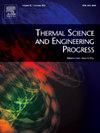Experimental investigation on temperature distribution and evolution of air-cooled PEMFCs under various operating conditions
IF 5.1
3区 工程技术
Q2 ENERGY & FUELS
引用次数: 0
Abstract
Proton exchange membrane fuel cells are promising for clean energy applications, but thermal management remains a critical challenge. This study experimentally investigated the temperature distribution and evolution of an air-cooled proton exchange membrane fuel cell stack under various dynamic operating conditions. Using 60 thermocouples inserted into the cathode channels, the formation, development, and propagation of high-temperature regions were thoroughly studied. The research results indicated that temperature distribution became increasingly non-uniform with rising current density, particularly under overload conditions. Hot spots first appeared near the hydrogen inlet and air outlet, expanding to central regions as current density increased. Overload operation led to rapid temperature rises and the formation of thermal bridges between hot spots, highlighting the risks of thermal instability. Moreover, the study established a connection between temperature variations and water management problems. Anode flooding intensified heat generation and led to voltage fluctuations. In addition, it was found that the maximum temperature difference could serve as a sensitive indicator for detecting water flooding inside fuel cells. The results of this study are helpful for a better understanding of the internal thermal behavior of air-cooled proton exchange membrane fuel cells and are of great significance for optimizing their thermal management strategies.
不同工况下风冷pemfc温度分布及演化的实验研究
质子交换膜燃料电池在清洁能源应用方面很有前景,但热管理仍然是一个关键的挑战。实验研究了气冷质子交换膜燃料电池堆在不同动态工况下的温度分布和演化。利用60对插入阴极通道的热电偶,对高温区的形成、发展和扩展进行了深入研究。研究结果表明,随着电流密度的增大,温度分布越来越不均匀,特别是在过载情况下。热点首先出现在氢气入口和出风口附近,随着电流密度的增加向中心区域扩展。超负荷运行导致温度快速上升,热点之间形成热桥,凸显了热不稳定的风险。此外,该研究建立了温度变化与水管理问题之间的联系。阳极泛洪加剧了热的产生并导致电压波动。此外,还发现最大温差可以作为检测燃料电池内部水泛滥的敏感指标。该研究结果有助于更好地了解气冷质子交换膜燃料电池的内部热行为,对优化其热管理策略具有重要意义。
本文章由计算机程序翻译,如有差异,请以英文原文为准。
求助全文
约1分钟内获得全文
求助全文
来源期刊

Thermal Science and Engineering Progress
Chemical Engineering-Fluid Flow and Transfer Processes
CiteScore
7.20
自引率
10.40%
发文量
327
审稿时长
41 days
期刊介绍:
Thermal Science and Engineering Progress (TSEP) publishes original, high-quality research articles that span activities ranging from fundamental scientific research and discussion of the more controversial thermodynamic theories, to developments in thermal engineering that are in many instances examples of the way scientists and engineers are addressing the challenges facing a growing population – smart cities and global warming – maximising thermodynamic efficiencies and minimising all heat losses. It is intended that these will be of current relevance and interest to industry, academia and other practitioners. It is evident that many specialised journals in thermal and, to some extent, in fluid disciplines tend to focus on topics that can be classified as fundamental in nature, or are ‘applied’ and near-market. Thermal Science and Engineering Progress will bridge the gap between these two areas, allowing authors to make an easy choice, should they or a journal editor feel that their papers are ‘out of scope’ when considering other journals. The range of topics covered by Thermal Science and Engineering Progress addresses the rapid rate of development being made in thermal transfer processes as they affect traditional fields, and important growth in the topical research areas of aerospace, thermal biological and medical systems, electronics and nano-technologies, renewable energy systems, food production (including agriculture), and the need to minimise man-made thermal impacts on climate change. Review articles on appropriate topics for TSEP are encouraged, although until TSEP is fully established, these will be limited in number. Before submitting such articles, please contact one of the Editors, or a member of the Editorial Advisory Board with an outline of your proposal and your expertise in the area of your review.
 求助内容:
求助内容: 应助结果提醒方式:
应助结果提醒方式:


